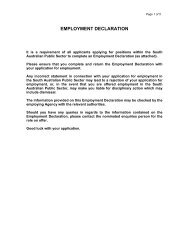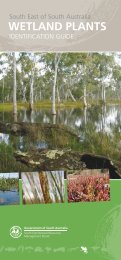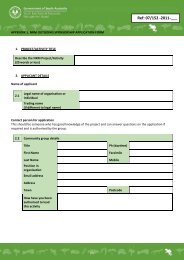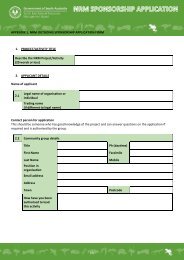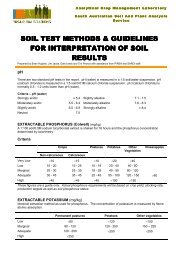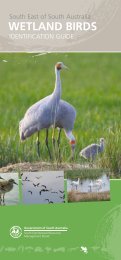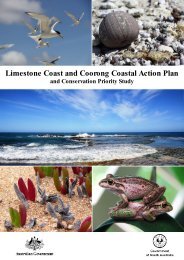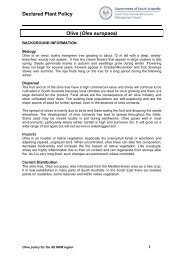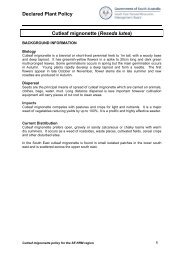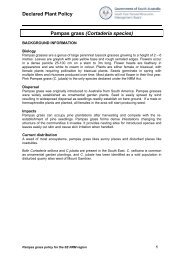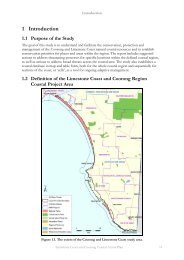Cell Descriptions - South East Natural Resources Management Board
Cell Descriptions - South East Natural Resources Management Board
Cell Descriptions - South East Natural Resources Management Board
Create successful ePaper yourself
Turn your PDF publications into a flip-book with our unique Google optimized e-Paper software.
SE8 – Rivoli Bay<br />
Biota<br />
There are 7 flora survey sites, 2 opportune flora sites, 22 Herbarium record sites, 1 fauna survey<br />
sites, and 31 opportune fauna survey sites. There 1017 ha. of remnant vegetation – 25.7% of the<br />
cell.<br />
Sand dunes make up 88% of the cell, approximately ¼ of these are vegetated with open coastal<br />
shrubland: Leucopogon parviflorus, Acacia longifolia ssp. sophorae, Olearia axillaris, +/-Myoporum insulare<br />
tall shrubland over Lepidosperma gladiatum, Pimelea serpyllifolia ssp. serpyllifolia, Isolepis nodosa sedges<br />
over Carpobrotus rossii, Clematis microphylla var. microphylla. Small corridors of sedgeland are found in<br />
the inter-dunal troughs. Mullins Swamp is Gahnia filum sedgeland, with Juncus kraussii and<br />
Melaleuca halmaturorum.<br />
95 fauna species have been recorded in the cell including 73 birds, 4 butterflies, 19 mammals, 20<br />
reptiles and 4 amphibians. Listed species include the EPBC listed critically endangered Orangebellied<br />
Parrot(Neophema chrysogaster) .<br />
Benthic Habitat<br />
Bare sand to 200m - 1200m. offshore, then low profile reef and heavy limestone reef. Scattered<br />
seagrass remnants throughout the bay.<br />
Land Use/ Land Ownership<br />
18% of the vegetated cell area is Crown Land Act Reserve (Mullins Swamp) (a total of 7% of<br />
the total cell area is Crown Land Act Reserve). Heritage Agreements 197001 and 197002 (dune<br />
shrubland adjacent Mullins Swamp) cover 15% of the cells vegetated area. Scattered unallotted<br />
Crown land parcels north of <strong>South</strong>end and a narrow Crown land coastal reserve along the<br />
shoreline of Rivoli Bay comprise 6% of the total cell area. These scattered unallotted Crown land<br />
parcels are interspersed amongst a patchwork of privately owned allotments covering the dunes<br />
north of <strong>South</strong>end. The majority of the unvegetated land in the cell is farmed or grazed.<br />
Mullins Swamp, (with nearby Lake Frome) was included on the Register of the National Estate in<br />
1993 because of its outstanding wetland conservation values.<br />
Values/ Uses (Field visits and local reports)<br />
Much of the dune ridge land has been cleared and grazed. 20 th Century grazing damage initiated<br />
extensive blow out development in the southern half of the cell (stabilised by marram – Cullen &<br />
Bird 1982). Aboriginal Heritage values throughout.<br />
Threats (Field visits and local reports)<br />
ORV use on the beach threatens shorebird activity. In addition, wrack harvesting from within the<br />
bay impacts on shorebirds and the beach and nearshore ecosystems. Drain discharge into Rivoli<br />
Bay has likely led to the loss of extensive seagrass meadows that were recorded in historic records<br />
in proximity to <strong>South</strong>end.<br />
Opportunities<br />
Mullins Swamp is an artificially permanent freshwater swamp in the <strong>South</strong> <strong>East</strong> and is described<br />
as an invaluable waterbird refuge with high bird habitat diversity (SEWCDB, 1984 in Slater and<br />
Farrington 2010). The site is scored in the mid-high range for biological value and wetland<br />
attributes. It has historically been considered as a single wetland unit incorporating Lake Frome<br />
(SEWC, 1984, Environment Australia, 2001) however, current management recognises Lake<br />
Frome and Mullins Swamp as discrete units. This is due to them having a different topography,<br />
hydrology and grazing regime as well as different tenure. In addition to the less common Crakes<br />
and Rails which frequent the swamp, the area is an important breeding site for Straw-necked Ibis.<br />
It also contains important emergent wetland habitat including fringing Cutting Grass sedgeland<br />
Limestone Coast and Coorong Coastal Action Plan 333



